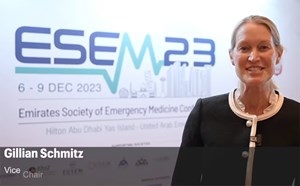
NIH Grant Supported Research Fellowships for EM/CCM Providers
Background
For many practitioners of EM and CCM, a strong interest in research accompanies other career goals in clinical practice and medical education. While there are many options for developing this interest, one significant question that must be addressed, usually before or during a critical care fellowship, is whether a second fellowship, dedicated towards research training and skills acquisition, is the right next step. For emergency physicians (EPs) with a true focus on biomedical or clinical research, a fellowship can support this goal and expedite progress towards independence.
While certainly not necessary for the development of a meaningful and productive academic career, a research fellowship offers increased time for mentorship and research training. In a sample of EPs with independent National Institutes of Health (NIH) career development awards, 60% reported completion of a research fellowship prior to their award.1 For R01 recipients in EM, the rate of prior research training is even higher at 94%.2 EM overall, however, does not show an excellent track record for formal research funding acquisition. In comparison to several similar medical fields (internal medicine, pediatrics, anesthesiology, and family medicine), EM has historically ranked lowest in NIH grant amounts and the number of awards per faculty member.3 Over a 10 year period from 2006 to 2016, only 264 R01 level grants were achieved in EM.4 As a specialty, encouraging research training will be a necessary step in reversing these trends and creating a culture of research in EM.5
Options for research fellowships vary widely, with self-funded and grant-supported programs being an important distinction. Among the grant-supported EM research fellowships, new options include the emergence of NIH-funded T32 programs and return of K12 programs. This article will describe research fellowships, directed to prospective applicants, focusing on the NIH-funded programs, with the Clinician Scientist Training Program T32 award in EM at the Mount Sinai Health System as a model.
Research Fellowship Basics
In comparison to CCM fellowships, research fellowships are generally less regulated, since they do not conform to Accreditation Council for Graduate Medical Education (ACGME) requirements for certification. A list of research fellowships is maintained by the Society for Academic Emergency Medicine (SAEM) (https://www.saem.org/resources/services/fellowship-approval-program/research-fellowship), including specially designated “SAEM-approved” positions. These have additional quality appraisal, but no true central regulatory authority exists for these positions. Prospective applicants to research fellowships should be advised to seek institutions with high success rates on grant applications, multiple R01-level funded research mentors, and plentiful resources, since these are positively associated with funded awards for trainees in these programs, as well.6
Research fellowship positions, unless grant-supported, may not be expected to fill yearly, but rather exist to support interested early-career researchers in ad-hoc fashion. Many research positions do not advertise, and the application process can be idiosyncratic according to the institution. Likewise, clinical work requirements, research support, formal coursework, and salary and benefits can be widely variable across different programs. Clinically, researchers may come onto faculty for a part-time position, at either an instructor or assistant professor level. Generally, some combination of guaranteed mentorship, reduced clinical and administrative load, and training in research skills is provided over a period of one to three years for most programs.
A research fellowship should have leaders in clinical or basic science research attached to the program, with established track records of mentorship and multiple ongoing projects. Frequent meetings with research mentors should be planned throughout the fellowship time. In addition to mentored instruction in research skills, some research fellowships, including all NIH-funded programs, provide formal coursework resulting in the acquisition of a research degree for those coming in without one. This degree may be an MPH or MS in any research discipline that will benefit the fellow. NIH-funded programs will pay for this degree from grant funds, but self-funded research fellowships will vary in their support for tuition.
NIH/NHLBI Grant-Supported Research Fellowships
Of the research fellowships available, special distinction should be made for the smaller subset of grant-supported fellowships made possible through the NIH. Although a full discussion of NIH granting mechanisms is beyond the scope of this article, current options within EM research training include either institutional “training” awards, specifically the T32, or institutional “career-development” awards, specifically the K12 programs, both funded through the National Heart, Lung and Blood Institute (NHLBI). Two T32 programs currently exist in emergency care research, the first at the Icahn School of Medicine at Mount Sinai, and another at the University of Pittsburgh. The four current EM K12 programs are at Indiana University School of Medicine, Oregon Health & Science University, Vanderbilt University, and the University of Michigan.
The current group of EM K12 programs will attempt to duplicate the impressive results from the earlier NIH/NHLBI grant which lasted for six years from 2011-2017 and included six sites for scholar training (Icahn School of Medicine at Mount Sinai; Oregon Health & Science; University of California, Davis Medical Center; University of Pennsylvania; University of Pittsburgh; Vanderbilt University Medical Center).7 This grant supported 43 scholars and generated 669 publications. Of entrants, 93% submitted applications for independent funding, with a 60% success rate by the study end date, during a time at which NHLBI success rates for K-awards was between 30-50% and new R01 awards in the 13-20% range.7,8 Of the original cohort of training sites, two form part of the new K12 grant program, with two other sites now using the T32 mechanism for their research training programs.
The awards differ on many points, including salary support from the NIH grant ($100,000 for K, roughly $57,000 for T depending on PGY-level), and research support (higher for K). For CCM applicants, one of the most important considerations should be the length of the program and the required clinical effort. K-awards all require, and rigorously enforce, 75% effort towards research and research training activities and specifically limit all non-research related activities (eg, clinical, administrative, and teaching) to 25% effort. This limit includes all clinical work, at any location, with onerous penalties to the institution if they are found to be non-compliant with this restriction. In comparison, while T-awards require that the fellowship be done full time, they can be more flexible with regards to clinical duties, and moonlighting may be permitted at the discretion of the program director.
It should be noted that the $100,000 in salary support provided by the K awards virtually never covers 75% of a faculty member’s salary, though it requires they have 75% protected time. At institutions where K12 scholars receive salaries higher than the sum of the NIH-stipend plus the 25% clinical pay, the local institution usually makes up the difference using departmental funds. There may also be a salary gap for T32 fellows, though this depends entirely on the fellowship salary, the level of clinical activity incorporated into the fellowship, and the amount of moonlighting permitted. Nevertheless, because of their outside funding support, both of these funded programs tend to have better salary compensation compared to self-funded programs, in which a trainee essentially “buys down” their clinical time by reducing their own salary.
Grant Support After the Research Fellowship
The primary effort commitment in a research fellowship is the production of original scholarly work that builds a fellow’s experience, establishes them as a promising future investigator, and prepares them for the next step along the pathway towards research independence. While K-awards may require specific projects to be proposed as part of the application packet, T-awards do not require project specifics for prospective fellows. For both the K12 and the T32 Programs, the usual expectation is submission of an application for an individual research grant award, usually a K08 or K23 grant, to continue their mentored research work while allowing new candidates to participate in the K12 or T32 program. The individual K08 and K23 awards have similar financial commitments, research requirements, and clinical limitations from the NIH as the K12. These grants show evidence of continued funding success for the applicant, while protecting dedicated research time for meaningful academic projects. A total of six years for all K-awards (institutional or individual) cannot be exceeded, meaning that K12 programs will reduce the time allowed for individual awards. An individual version of the T32 award also exists, and this “fellowship” award or F32-award may be used to fund part of the fellowship period. There is a limit of three years total on a T32 or F32 award. However, neither being in a T32 program nor having an F32 award will reduce an individual’s K allowance.
EM physicians have demonstrated comparable success rates for individual K-award funding to other medical specialties, but we have historically ranked amongst the lowest for number of grant applications submitted per graduating resident.9 In the future, the reputation of our specialty as experts in emergency and critical care medicine may depend on improving our number of dedicated independent researchers.
Other options to fund research training include Emergency Medicine Foundation (EMF) or Society for Academic Emergency Medicine Foundation (SAEMF) grants, or other society or foundation awards. There are also institutional KL2 Programs at medical schools that have clinical and translational science awards (CTSAs) and non-EM K12 programs at some sites, such as the Implementation Science K12 Program at Yale. Success at obtaining research funding through foundation sources or private industry funding, or even R-level awards from the NIH, would depend on the fellow’s education, experience, goals, and prospective research project.10
Clinical Time Considerations for EMCCM Practitioners
With limitations on clinical time imposed by research requirements, daytime classes in a master’s degree program, and most substantially with the 75% research effort requirement of a K-award, applicants will have substantially reduced ability to negotiate ICU time. In a T32, or in a self-funded fellowship, moonlighting can be permitted within an ICU, but fellows may find themselves with very few ICU days, or even being limited to nighttime-only coverage to maintain their skills. Nearly all EM-based research fellowships will have clinical time requirements within an ED. For EM/CCM graduates looking towards individual K-awards after a research fellowship, there may be additional options for negotiation for the breakdown of clinical duties but trying to maintain two clinical specialties with limited actual clinical effort can be problematic, although not absolutely impossible.
Clinician Scientist Training Program T32 Award in Emergency Medicine at the Mount Sinai Health System
At Mount Sinai Health System, the Department of Emergency Medicine has a strong record of research achievement, particularly with mentoring early-career researchers towards independent careers. As one of the sites of the prior K12 program for emergency care research, the research division within the department has experienced mentors for fellows at this level of training. The T32 fellowship here, about to start its 3rd year, provides for two or three years of research support through its NIH grant. The program is led by Dr. Lynne Richardson, MD, a recipient of countless awards for research, education, and mentorship. Associate program directors for the fellowship are Jason Shapiro, MD, MA, and Alex Manini, MD, MS, both experienced mentors and recipients of NIH R01 funding for research projects within EM.
Beyond mentorship, the program at Mount Sinai includes tuition funding for a master’s research degree, which can be done at Mount Sinai or at another institution if approved by the program director. The research division’s resources are robust, and include conferences for project development, grant advisors, research associates for project enrollments, and local leadership in trial networks such as the PETAL network. The program’s location, in the upper east side neighborhood of Manhattan in New York City, puts the fellow in the heart of the nation’s most bustling and vibrant city with endless opportunities for exploration.
Summary
Ultimately, the decision to go into a research fellowship for any applicant, but especially for an EM/CCM physician, is complex. The additional fellowship will result in some loss of financial compensation in comparison to entering directly into clinical practice, although for physicians desiring research careers working in academic hospitals, this sacrifice will probably already have been considered. One of the biggest considerations for EM/CCM graduates should be the clinical time restriction, given that many will either desire to split time between EM and CCM or will not have entirely decided on limiting themselves to just one of these disciplines.
As mentioned above, the biggest benefit for prospective applicants to research fellowships from EM/CCM backgrounds is the acquisition of additional research skills, degree certification in a research discipline, and protected time to jumpstart an academic career. If applicants are not interested in making research a primary component of their future practice, or if grant support will not be a planned part of the applicant’s research efforts, then the benefits of the research fellowship may be limited, given the restrictions imposed during the fellowship time. Graduates of EM/CCM programs with a focus on education or simulation activities may also see limited returns on the investment of time in a research fellowship. For the budding EM/CCM graduate with a strong research interest and a goal of having independent, grant-funded protected research time in the future, the research fellowship can empower them towards meaningful projects with benefits that extend far past the actual fellowship itself.
References
- Nishijima DK, Offerman SR, Ballard DW, et al. Risk of traumatic intracranial hemorrhage in patients with head injury and preinjury warfarin or clopidogrel use. Acad Emerg Med. 2013;20(2):140-145.
- Scott Van Epps J, Younger JG. Early career academic productivity among emergency physicians with R01 grant funding. Acad Emerg Med. 2011;18(7):759-762.
- Bessman SC, Agada NO, Ding R, Chiang W, Bernstein SL, McCarthy ML. Comparing National Institutes of Health funding of emergency medicine to four medical specialties. Acad Emerg Med. 2011;18(9):1001-1004.
- Antony M, Savino J, Ashurst J. Difference in R01 Grant Funding Among Osteopathic and Allopathic Emergency Physicians over the Last Decade. West J Emerg Med. 2017;18(4):621-623.
- Ranney ML, Limkakeng AT, Carr B, Zink B, Kaji AH. Improving the emergency care research investigator pipeline– SAEM/ACEP recommendations. Acad Emerg Med. 2015;22(7):849-851.
- Mumma BE, Chang AM, Kea B, Ranney ML, Society for Academic Emergency Medicine Research Committee. Career Development Awards in Emergency Medicine: Resources and Challenges. Acad Emerg Med. 2017;24(7):855-863.
- Newgard CD, Morris CD, Smith L, et al. The First National Institutes of Health Institutional Training Program in Emergency Care Research: Productivity and Outcomes. Ann Emerg Med. 2018;72(6):679-690.
- Success Rates - NIH Research Portfolio Online Reporting Tools (RePORT).
- Brown J. National Institutes of Health support for individual mentored career development grants in emergency medicine. Acad Emerg Med. 2014;21(11):1269-1273.
- Young KD, 2005-2006 Society for Academic Emergency Medicine Grants Committee, 2006-2007 Society for Academic Emergency Medicine Grants Committee. Productivity and career paths of previous recipients of Society for Academic Emergency Medicine research grant awards. Acad Emerg Med. 2008;15(6):560-566.
Patrick J. Maher, MD
Assistant Professor, Emergency Medicine and Critical Care Medicine
Icahn School of Medicine at Mount Sinai



